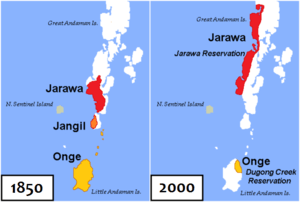Ongan languages
| Ongan | |
|---|---|
| South Andamanese | |
| Geographic distribution: | Andaman Islands |
| Linguistic classification: | One of the world's primary language families; geographically among the Andamanese languages |
| Subdivisions: | |
| Glottolog: | jara1244[1] |
|
Distribution of the Ongan languages prior to 1850 (Fig. 1) and in 2005 (Fig. 2) | |
Ongan, also called South Andamanese or Jarawa–Onge, is a small family of two languages, Önge and Jarawa, spoken in the southern Andaman Islands:
The two extant languages are:
- Önge or Onge (⟨ö⟩ transcribes /ə/); 96 speakers (Onge) in 1997, mostly monolingual
- Jarawa or Järawa; estimated at 200 speakers (Jarawa) in 1997, monolingual
A third language, Jangil, extinct sometime between 1895 and 1920, is reported to have been unintelligible with but to have had noticeable connections with Jarawa.
Classification
The Andamanese languages fall into two clear families, Great Andamanese and Ongan, plus one presumed but unattested language, Sentinelese. The similarities between Great Andamanese and Ongan are mainly of a typological and morphological nature, with little demonstrated common vocabulary. Linguists, including long-range researchers such as Joseph Greenberg, have expressed doubts as to the validity of Andamanese as a family.[2] It has since been proposed that Ongan (but not Great Andamanese) is distantly related to Austronesian in a family called Austronesian–Ongan,[3] but the proposal has not been well received.
The two attested Ongan languages are relatively close, and the historical sound reconstruction mostly straightforward:
| Proto-Ongan | *p | *b | *t | *d | *kʷ | *k | *ɡ | *j | *w | *c | *ɟ | *m | *n | *ɲ | *ŋ | *l | *r |
|---|---|---|---|---|---|---|---|---|---|---|---|---|---|---|---|---|---|
| Jarawa | p, b | b | t | d | hʷ, h | h | ɡ, j | j | w | c | ɟ | m | n | ɲ | ŋ | l | r |
| Onge | b | b | t, d | d, r | kʷ, h | k, ɡ | ɡ, Ø | j | w | c, ɟ | ɟ | m | n | ɲ | ŋ | l, j | r/j/l, Ø |
| Proto-Ongan | *i | *u | *a | *e | *o | (*ə) |
|---|---|---|---|---|---|---|
| Jarawa | i | u | a | e, ə, o | o | (ə) |
| Onge | i | u | a | e, ə, o | o | (ə) |
*ə appears to be allophonic for *e before a nasal coda.
Grammar
The Ongan languages are agglutinative, with an extensive prefix and suffix system.[5][6] They have a noun class system based largely on body parts, in which every noun and adjective may take a prefix according to which body part it is associated with (on the basis of shape, or functional association).[7] Another peculiarity of terms for body parts is that they are inalienably possessed, requiring a possessive adjective prefix to complete them, so one cannot say "head" alone, but only "my, or his, or your, etc. head".[7]
The Ongan pronouns are here represented by Önge:
| I, my | m- | we, our | et-, ot- |
| thou, thy | ŋ- | you, your | n- |
| he, his, she, her, it, its | g- | they, their | ekw-, ek-, ok- |
There is also an indefinite prefix ən-, on- "someone's". Jarawa does not have the plural series, but the singular is very close: m-, ŋ- or n-, w-, ən-. From this, Blevins reconstructs Proto-Ongan *m-, *ŋ-, *gw-, *en-.
Judging from the available sources, the Andamanese languages have only two cardinal numbers: one and two and their entire numerical lexicon is one, two, one more, some more, and all.[6]
Bibliography
- Blevins, Juliette (2007), "A Long Lost Sister of Proto-Austronesian? Proto-Ongan, Mother of Jarawa and Onge of the Andaman Islands" (PDF), Oceanic Linguistics, 46 (1): 154–198, doi:10.1353/ol.2007.0015 (available here)
- Das Gupta, D. and S. R. Sharma. A Handbook of the Önge Language. Anthropological Survey of India: Calcutta 1982.
- E. H. Man, Dictionary of the South Andaman Language, British India Press: Bombay 1923.
- Senkuttuvan, R. 2000. The Language of the Jarawa: Phonology. Calcutta: Anthropological Survey of India, Government of India, Ministry of Culture, Youth Affairs, and Sports, Dept. of Culture.
- Sreenathan, M. 2001. Jarwa - Language and Culture. Anthropological Survey of India, Ministry of Culture, Government of India, Kolkata
References
- ↑ Hammarström, Harald; Forkel, Robert; Haspelmath, Martin; Bank, Sebastian, eds. (2016). "Jarawa–Onge". Glottolog 2.7. Jena: Max Planck Institute for the Science of Human History.
- ↑ Greenberg, Joseph (1971). "The Indo-Pacific Hypothesis." Current Trends in Linguistics Vol. 8, ed. by Thomas A. Sebeok, 807.71. The Hague: Mouton.
- ↑ Blevins, Juliette (2007), "A Long Lost Sister of Proto-Austronesian? Proto-Ongan, Mother of Jarawa and Onge of the Andaman Islands" (PDF), Oceanic Linguistics, 46 (1): 154–198, doi:10.1353/ol.2007.0015
- 1 2 Blevins (2007:163–164)
- ↑ Abbi, Anvita (2006). Endangered Languages of the Andaman Islands. Germany: Lincom GmbH.
- 1 2 Temple, Richard C. (1902). A Grammar of the Andamanese Languages, Being Chapter IV of Part I of the Census Report on the Andaman and Nicobar Islands. Superintendent's Printing Press: Port Blair.
- 1 2 Burenhult, Niclas (1996). "Deep Linguistic Prehistory with Particular Reference to Andamanese." Working Papers 45, 5-24. Lund University: Department of Linguistics
